Motorsports
Was a secret front wing upgrade key to Ferrari’s US GP dominance?
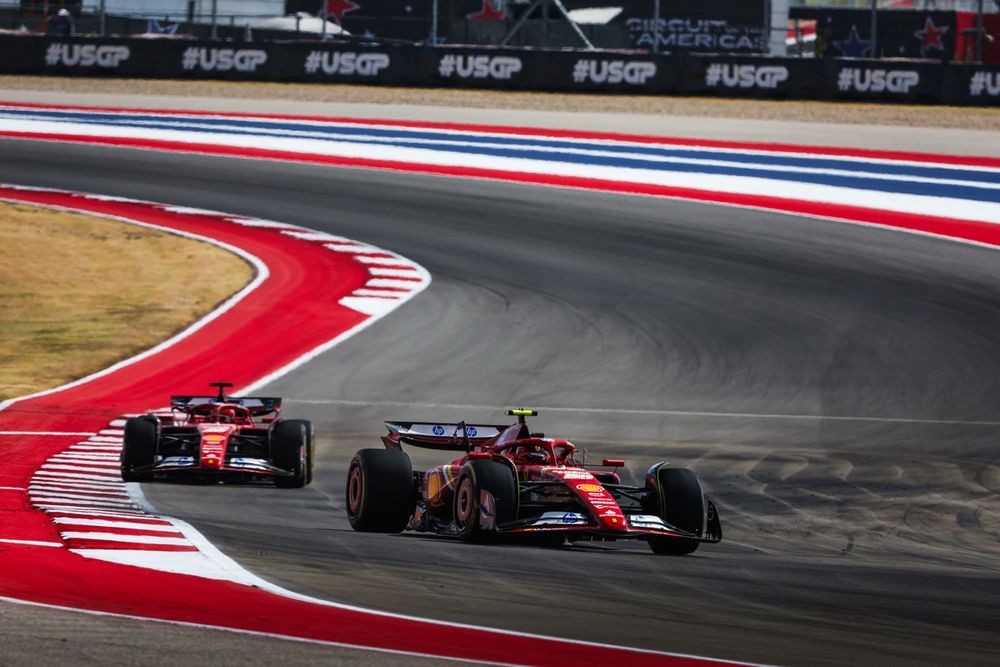
Ferrari’s dominance of the United States Grand Prix came on a weekend when it stood out from its rivals in not bringing any upgrades. Or, to be more accurate, none that it officially declared.
With closest challengers McLaren, Red Bull and Mercedes all introducing developments at the Austin track, the FIA’s official submission sheet that details changes showed no tweaks to the Ferrari car.
But that does not tell the true story of Ferrari’s approach to the USA weekend, as there are certain tweaks teams can make that do not have to be declared.
Article 19.1c) of F1’s sporting regulations, which covers what items teams have to tell the FIA about, states that this includes “all major aerodynamic and bodywork components and assemblies that have not been run at a previous Competition or TCC [test] and are intended to be run at the competition.”
Indeed, after seeing Charles Leclerc and Carlos Sainz take a 1-2 finish, Ferrari team principal Fred Vasseur repeated several times that just because no upgrades were declared, it did not mean the Prancing Horse did not have any.
“It is not that because we are not declaring something that we are not bringing something,” he said. “We have to be clear that the upgrades are about the external shape.”
Carlos Sainz, Ferrari SF-24, Charles Leclerc, Ferrari SF-24
Photo by: Ferrari

Ferrari did not elaborate on what exactly was new for Austin, but speculation has surrounded the possibility that it brought some new specification front wings.
While these externally are identical to what it first introduced in Singapore, insiders suggest Ferrari had spent some time since the last race working on optimising their construction to help exploit aero elasticity more.
In a season when having a more flexible front wing has been instrumental in better balancing a car – helping address the low-speed understeer and high-speed oversteer characteristics of the current ground effect machinery – Ferrari had perhaps been too cautious at the start of the season.
And while it privately felt that others were pushing the boundaries too much in how much flexing was going on, recent FIA clarifications that such behaviour is allowed opened the door for Maranello to go down this route itself now too.
A more optimised flexi-wing is not something that will transform a car but, in a season where the gaps between teams are so close, it is a detail that can have an impact.
Speaking about the value of a good flexi front wing after what we saw in Austin, Vasseur said: “Clearly it is not a game-changer, but we are in the situation today that every single hundredth of a second is making a difference.
“In qualifying we had two or three cars behind us by less than one-tenth, and that meant if these details or another one are down to the hundredths of a second, then we have to do it.”
The new wing design that originally appeared in Singapore is an evolution of its predecessor, with many of the design features retained, albeit more deliberate in their approach.
In terms of the actual design changes to the wing, aside from the obvious flap geometry changes, the design of the spoon-shaped transition from the centre of the mainplane has been altered. This will, in turn, provide a different aerodynamic reaction from the nose assembly.


Meanwhile, the outboard section of the flaps has been redesigned where they mate with the endplate. This is in order to enhance the outwash effect being generated and alter the wake generated by the wheel and tyre assembly behind.
The new flap tips are much more roundly curved (left image, above) and the supporting metal work that had previously been employed has been cast aside, which will alter their dynamic behaviour as a consequence.
Ferrari is also undoubtedly benefiting from a wing designed with a greater ability to exploit aeroelasticity, given the FIA’s clearance of solutions fielded by its rivals in recent races.
Motorsports
The question marks lingering after Verstappen vs Norris in Austin
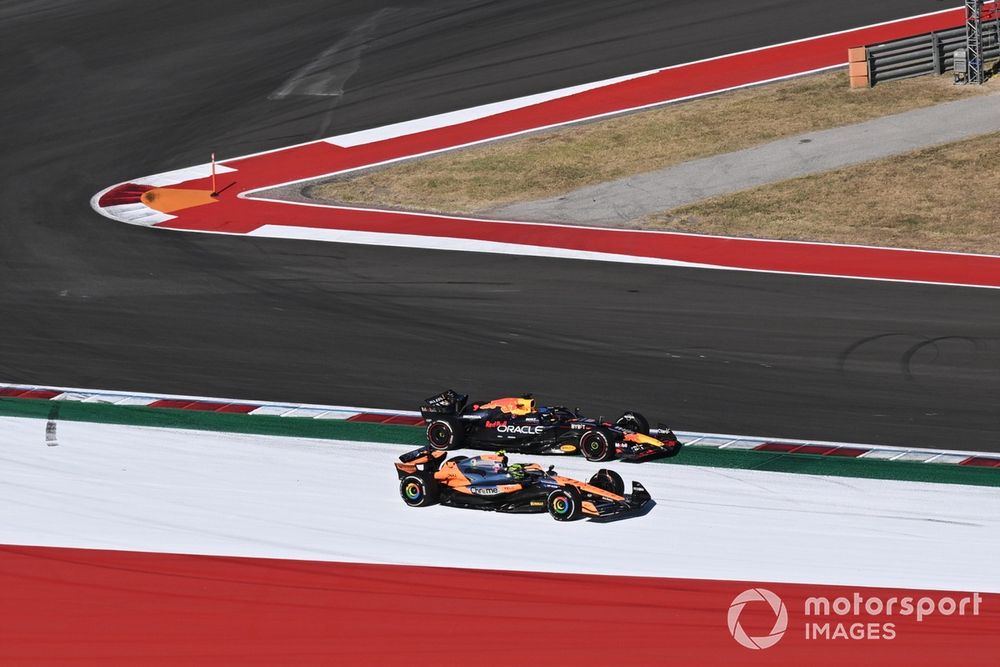
Rather than celebrating two elite drivers racing on the edge or applauding Ferrari’s impressive one-two victory, talk after the US Grand Prix once again shifted to regulations, stewarding consistency, and track limits.
Verstappen followed F1’s racing guidelines, but are they fit for purpose?
The incident unleashed differing comments from both sides, with Red Bull pointing out Norris made an illegal overtake off the track – an argument which the race stewards followed – while McLaren argued that drivers shouldn’t be allowed to just crowd a competitor off the road.
As Verstappen has apparently understood better than anyone else, the current driving standards guidelines encourage the defending car on the inside to just release the brakes and ensure it is ahead at the apex without having to give the car on the outside any room at the exit, a line of thinking which makes overtaking around the outside even more difficult that it already was.
Mercedes was apoplectic that Verstappen didn’t get punished while George Russell did for a similar-looking offence driving Valtteri Bottas off, but because the Mercedes driver was the attacker and overtook on the inside, the guidelines say Russell did have the responsibility to leave a car’s width for the Sauber at the exit.
Interestingly, the guidelines are just written from the attacking car’s point of view, including the requirement to drive in a safe and controlled manner and be able to make the corner within the track limits. That Verstappen did not do so was a mitigating factor in Norris only getting a five-second penalty as opposed to 10, and also explains why Norris wasn’t penalised for his fourth track-limits offence.
Lando Norris, McLaren MCL38, battles with Max Verstappen, Red Bull Racing RB20
Photo by: Sam Bagnall / Motorsport Images

Then there is another interpretation for the first lap of a race, where stewards take a much more relaxed “let them race” approach. That means drivers are less afraid of having a go at each other at Turn 1 for fear of being penalised, but at the same time it doesn’t help fans understand where the consistency is.
It is clear that the guidelines are just that, and only indicative of how the stewards might judge a particular incident. They offer room for interpretation, which in this case Red Bull and McLaren did differently. Those guidelines are supposed to see widespread adoption across all levels of FIA sanctioned racing in 2025, down to grassroots racing, but are now likely to return to the agenda as a point of discussion, as Jonathan Noble explains in detail.
But what if in future cases the guidelines allowed the attacking car to stay ahead when being forced off? Would we end up seeing more wheel-to-wheel racing within the white lines rather than outside? That is a question for F1 and the FIA to answer over the coming months before the guidelines become a part of the wider FIA playbook. But many feel the current system is too confusing and open to interpretation, and doesn’t necessarily promote fair racing.
How much time should stewards take to make decisions?
McLaren also lamented that the FIA stewards made a call to penalise Norris within several minutes and before the end of the race. Team principal Andrea Stella felt that meant the stewards couldn’t take into account what both drivers and teams had to say about the matter. “When the case is so difficult, like Lando and Max, just take the time, review it after the race and hear from the drivers, try to understand the subtleties,” he said.
The quick decision making particularly affects cars finishing at the front, as it stems from a desire from the FIA and F1 to ensure the right driver is on the podium. Having a driver take to the rostrum only to be penalised and demoted hours after the race is an outcome nobody wants, so stewards are entitled to make a swift decision if they feel the case is clear enough.
Is this actually a track problem, and is gravel the solution?
Oscar Piastri, McLaren MCL38, runs through the gravel
Photo by: Mark Sutton / Motorsport Images
After numerous track-limits offences made a complete mockery of the 2023 Austrian Grand Prix, the FIA made well considered changes for this year, adding narrow gravel strips at several corners. The solution wasn’t perfect, as McLaren’s Oscar Piastri still managed to fall victim of a contested track-limits call in qualifying.
But the general idea was sound. Installing strips of gravel within a car’s width of the white line ensures corners naturally punish drivers for going wide before they actually cross the track limits. If there had been a gravel strip on the outside of Turn 12, would Norris still have persisted with his around-the-outside move? And would Verstappen have been as cavalier with the way he released the brakes to make sure he would be ahead at the apex and earn the right to the corner, less interested in whether he would actually make the corner or not?
On street circuits the walls will take care of that, while on natural road courses the fact that certain circuits – like COTA – also host bike racing can be an issue. But the Red Bull Ring, which too welcomes MotoGP, shows temporary or modular solutions can be implemented at relatively limited cost.
So, while questions will be raised over rules and officiating consistency, taking the decision out of stewards’ hands to begin with by letting the track set natural boundaries is the solution that has been right under our noses all along.
Motorsports
Dakar winners Price, Sunderland switch to four wheels in 2025
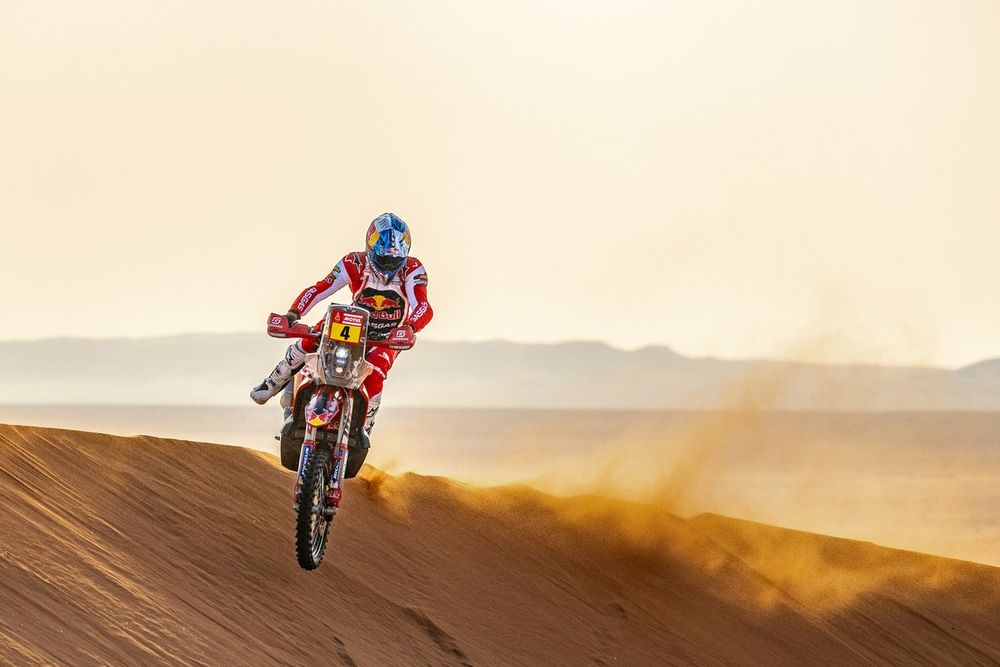
Dakar Rally winners Toby Price and Sam Sunderland will switch from the motorcycle category to cars to contest the 2025 edition together in January.
The pair will be aboard an Overdrive Racing Toyota Hilux T1+ for the gruelling Saudi Arabian rally raid from 3-17 January.
Price, who won Dakar in 2016 and 2019, will have Sunderland as his co-driver after the Australian was left without a ride as KTM did not renew his contract for 2025.
He said on social media: “I am excited to announce that we are going to Dakar in January. Super excited for this chance, we are going to be with Overdrive and going to jump in a T1+ car and see what we can do.
“The other good news is I’ll be teaming up with a good mate Sammy Sunderland, who will sit beside me and see what we can come up with. It’s going to be super exciting and a lot of hard work for us.”
Price and Sunderland are looking to join Hubert Auriol, Stephane Peterhansel and Nani Roma as the only individuals to have won the Dakar in both a car and bike.
Briton Sunderland, who retired from motorcycle racing in August having won Dakar in 2017 and 2022, said: “Me and Pricey are heading to Dakar. Even to say it out loud sounds pretty wild.
#4 Red Bull GASGAS Factory: Sam Sunderland
Photo by: GasGas Factory Racing
“I remember the days in Dakar, we’d sit in the camp after a long, rough day on the bike chatting about how nice it would be sat in a car.
“It always seemed pretty far-fetched but here we are. Super grateful for all the boys that have put some effort into getting this across the line, it’s a massive help for us and something that I’m really grateful for and hopefully we can do it justice.”
Toyota won the Dakar in 2022 and 2023 with Nasser Al-Attiyah, now part of the Prodrive-run Dacia Sandriders team.
The works Toyota Gazoo Racing roster for 2025 is likely to comprise Lucas Moraes/Armand Monleon and Seth Quintero/Dennis Zenz, who contested the recent Rallye du Maroc that concluded the 2024 World Rally-Raid Championship season.
Defending Dakar winner Carlos Sainz Sr will drive for Ford, having won the 2024 edition with Audi, as the Blue Oval enters its new Raptor T1+.
Motorsports
Marciello to defend FIA GT World Cup, all previous winners on 23-car entry
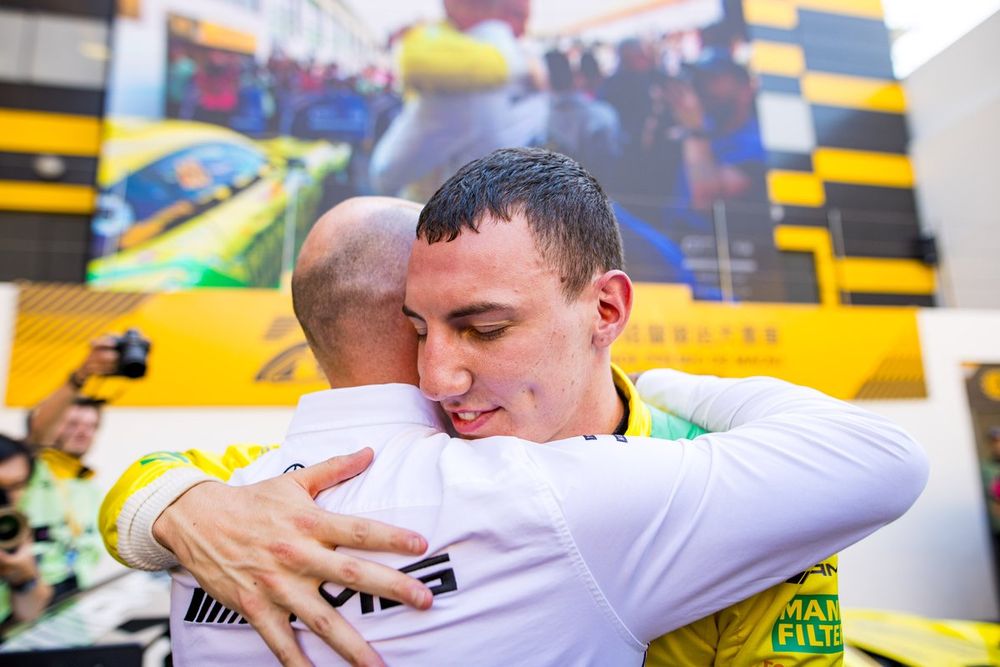
BMW factory driver Raffaele Marciello will defend his FIA GT World Cup title in next month’s Macau GT3 showpiece, which features all previous winners on the entry list.
Victorious last year with Mercedes, Marciello will line up as part of a 23-car field comprising representation from six manufacturers as he seeks a third victory in the event he also conquered in 2019, the last edition held before a three-year hiatus induced by the COVID-19 pandemic.
Marciello (Toro Racing powered by MCG) will be joined in BMW’s four-car roster by Augusto Farfus (Team KRC), who scored BMW’s only previous GT World Cup win in 2018, along with WRT pair Sheldon van der Linde and Dries Vanthoor.
“I have won the last two editions of the FIA GT World Cup, but this time the situation is completely new for me as I will be driving the BMW M4 GT3 there for the first time,” said Marciello.
“I have always had good fights with BMW in the past, especially with Augusto in 2018 and also in 2017. Now I am very much looking forward to being on the other side.
“I will do everything in my power to bring the trophy back to Munich.”
Race winner Raffaele Marciello, Mercedes-AMG Team Landgraf Mercedes-AMG GT3
Photo by: Mercedes AMG

Other previous winners on the entry list include Maro Engel (2015), Laurens Vanthoor (2016) and Edoardo Mortara (2017) with Mercedes, Porsche and Lamborghini respectively.
Newly-crowned GT World Challenge Europe Sprint champion Engel (GMR) is joined in the four-car Mercedes-AMG GT3 Evo roster by Ralf Aron (Toro Racing), 2011 Macau Grand Prix winner Dani Juncadella and Jules Gounon (both Craft-Bamboo).
WEC Hypercar points leader Vanthoor and Alessio Picariello will both be entered in Porsche 911 GT3 Rs by Absolute Racing, with newly crowned IMSA SportsCar Championship GTD Pro winner Laurin Henrich (Schumacher CLRT) and outgoing DTM champion Thomas Preining (Origine) also seeking to become Porsche’s first GT World Cup victors.
Lamborghini too has its sights set on a first victory in the event, and returns with works drivers for the first time since 2017.
Mortara and Matteo Cairoli’s Huracan GT3 Evo 2s will be run by Vincenzo Sospiri Racing under the VSR Theodore Racing banner, with DTM race winner Luca Engstler in a third Lamborghini entered by his family-run team.
Ferrari is also seeking a maiden victory in the event and has entered World Endurance Championship Hypercar drivers Antonio Fuoco and Yi Yifei, making their first GT World Cup appearances.
Fuoco, the outright Le Mans 24 Hours victor in 2023, will race a 296 GT3 run by the AF Corse team that operates his works 499P in the WEC, while Ye and fellow works driver Daniel Serra are fielded by Harmony Racing.
Audi is also present with R8 LMS GT3 Evo2s for works aces Christopher Haase (Phantom Global) and Ricardo Feller (FAW).
Motorsports
WRC points system change set for FIA vote
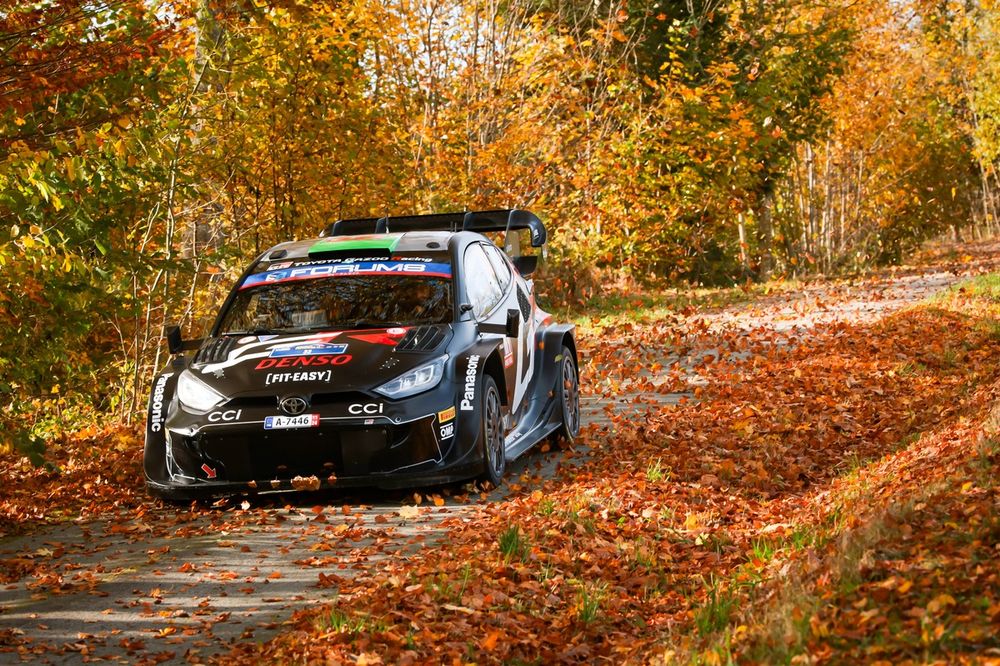
The FIA is confident it has an option to present to the World Motor Sport Council to improve and “simplify” the World Rally Championship’s radical points system for next year.
This year’s all-new points structure has proved a hot topic among competitors and fans thanks to its complexity and weighting that many feel has devalued the overall rally victory.
In 2024, points have been split across Saturday and Sunday, with drivers able to claim provisional points for their overall position at the end of Saturday’s leg which are then banked if they reach the end of the rally.
A sliding scale of 18-15-13-10-8-6-4-3-2-1 is awarded to the top 10 at the end of Saturday, but only to those crews who reach Sunday’s event finish.
In addition to this, Sundays offer up a separate points allocation [7-6-5-4-3-2-1] to the top seven fastest crews across Sunday’s stages on top of the 5-4-3-2-1 system for the top five times on the rally-ending Power Stage.
While the new system was designed to improve the action on Sunday and has been highly effective at creating excitement, drivers and teams have been highly critical of the points weighting of the system that has been derided on several occasions.
The ire seems to stem from the fact that a rally winner can quite easily leave the weekend without scoring the most points. This happened once again last weekend as Elfyn Evans, who finished second at the Central European Rally walked away with two more points than event winner Ott Tanak.
Elfyn Evans, Scott Martin, Toyota Gazoo Racing WRT Toyota GR Yaris Rally1
Photo by: Toyota Racing
As previously reported the FIA has been evaluating four new proposals to make improvements to the system for next year.
Speaking at last weekend’s Central European Rally the FIA has confirmed that it has a proposal that it will present to the World Motor Sport Council which could be in place for next year.
Motorsport.com understands that the weighting of the points to ensure the rally winner is rewarded more is part of the proposal.
“We have different options, we have been talking about this all season. Every two weeks we have a sporting working groups and different options are on the table coming from the driver’s representative Scott [Martin] and from the manufacturers and from the WRC Promoter.
“Finally, we think we have an option to be presented to the next commission that more or less all agree with,” said FIA WRC category manager Marina Dunach.
“It will go to a vote at the World Motor Sport Council and maybe we will have a new points system for next year.
“After looking at the different options presented we have been testing with Excel files what would happen using the different options and thinking what is the best for the championship. We all feel more or less that this is more fair, maybe.”
FIA road sport director Andrew Wheatley added: “The key priority for the [original] rule change was to try and ensure that we had less of a discussion about Sunday, it created other discussions which is normal, and now the proposal is to try and tweak to simplify it [the points system].”
Motorsports
Honda set for Castrol MotoGP partnership after Repsol split
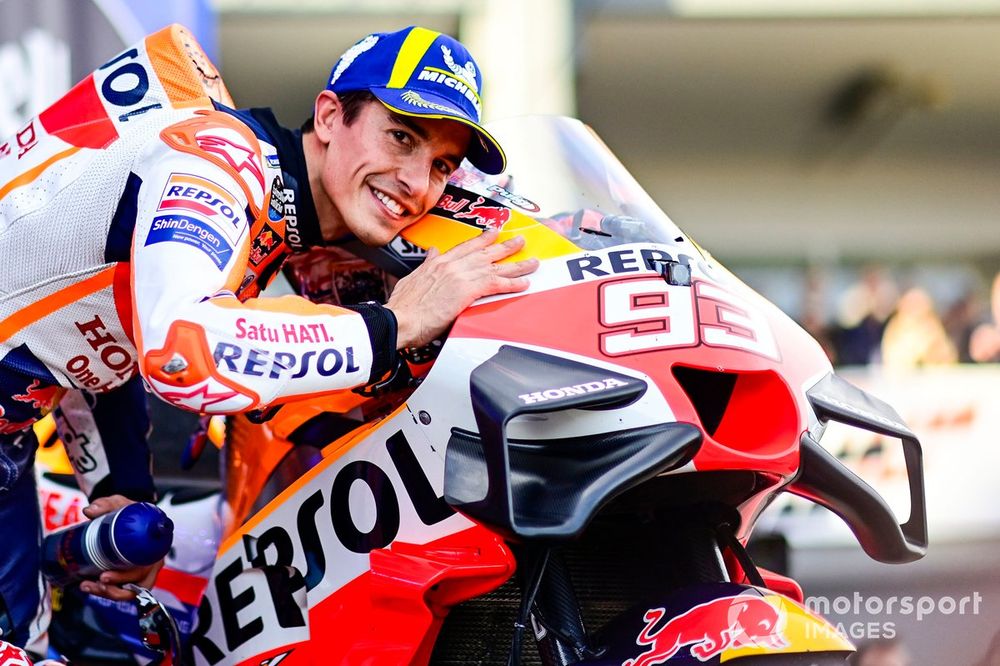
The Honda MotoGP factory team is finalising a deal with Castrol to replace Repsol from the 2025 season, Motorsport.com has learned.
Although it was an open secret for months, Repsol executives formally informed Honda of their intention not to extend their sponsorship deal – which expires at the end of this season – on the Sunday of this year’s San Marino Grand Prix.
With a brief statement sent just after the MotoGP race, the Spanish company put an end to 30 years of a relationship that began losing strength following the departure of Marc Marquez from the Japanese squad at the end of last year.
Marc Marquez, Repsol Honda Team
Photo by: Gold and Goose / Motorsport Images
Repsol’s financial contribution to HRC was considerably reduced once the Spanish rider’s departure to Gresini was confirmed, a circumstance that was reflected in the evident loss of the oil company’s logo on the RC213V, going from occupying a central place to moving to the underside of Joan Mir and Luca Marini’s bikes.
In fact, if the Honda manufacturer’s factory squad has continued to identify itself as the Repsol Honda Team, it has been thanks to a gesture of goodwill from the Japanese brand, which, in any case, has raced with its bikes decorated mainly in the corporate colours (red, blue and white), rather than black.
The Honda/Repsol partnership began in 1995 and has since produced a total of 15 riders’ titles, 10 constructors’ titles and 183 race victories.
With the break-up now just a few months away, Motorsport.com has learned that Honda has already agreed a deal with Castrol for the British oil company to fill the gap left by Repsol from next season onwards.
Castrol is one of the main partners of the LCR team, owned by Lucio Cecchinello, which has the fuel and lubricant company as a main sponsor on the side of the garage currently occupied by Johann Zarco.
The new partnership with the factory team does not, however, jeopardise the existing one with LCR.
While the relationship between Castrol and the Tokyo-based manufacturer’s factory team will not reach title sponsor status by 2025, the relationship could go further depending on a number of factors.
Motorsports
Norris “driving like a muppet” led to controversial Verstappen battle
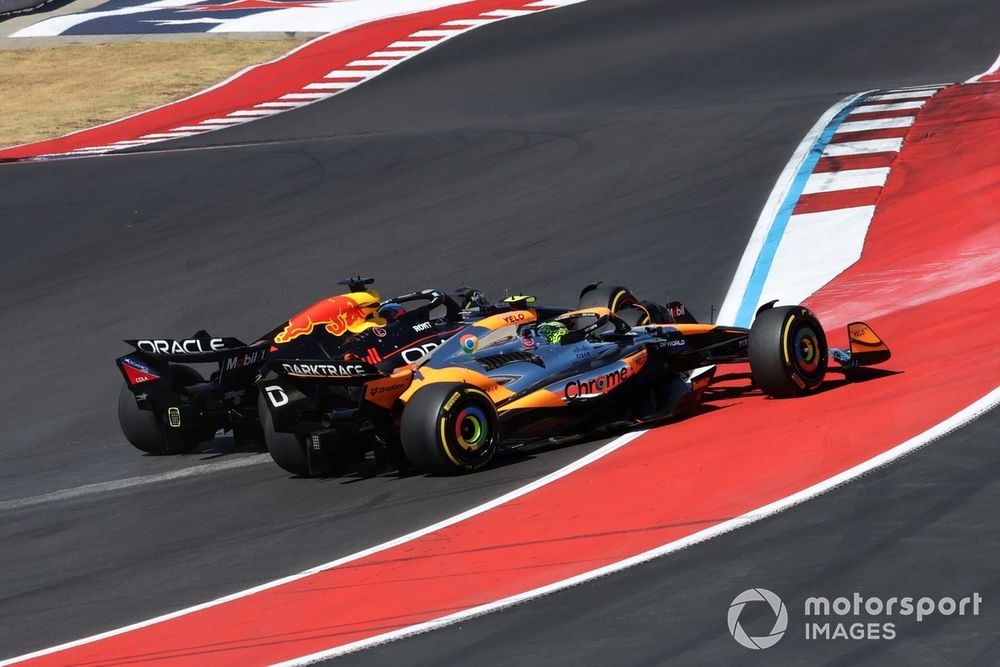
Lando Norris has conceded that “driving like a muppet” at the start of the Formula 1 United States Grand Prix ultimately led to the controversial battle with Max Verstappen.
The Red Bull driver made a lunge up the inside of Norris into the first corner, forcing both wide and allowing Charles Leclerc through into the lead on the way to an eventual dominant victory.
While Verstappen’s move could have brought repercussions for its forceful nature, the fact it was on lap one meant the race stewards dismissed the case.
When the duo met again at the end of the race with Norris trying to take the final podium spot, the three-time champion again pushed his title rival wide and, despite both running off-track, it was the McLaren that was penalised for leaving the track and gaining an advantage.
While much ire was directed towards the decision post-race, Norris held his hands up for leaving space for Verstappen to attack into the first corner, which eventually led to the late-race tussle.
“Turn one, I didn’t do the correct thing but I feel like what happened at the end of the race was more on my side. Otherwise, it was a good battle, and I enjoyed it. We just didn’t come out on top because I didn’t do a good enough job.
Max Verstappen, Red Bull Racing RB20, Lando Norris, McLaren MCL38, battle into turn 1
Photo by: Steve Etherington / Motorsport Images

“If I defended better in turn one and wasn’t driving like a muppet, then I should have led after Turn 1, and we shouldn’t have this conversation in the first place…”
McLaren team principal Andrea Stella was very careful not to direct anger towards Verstappen in his comments after the race, underlining his frustration was with the stewards and the state of F1’s rules.
Norris was also full of respect for his rival, insisting: “I think Max drove very well.
“It’s very hard to do what we’re doing, and it’s hard when you’re side by side, you’re completely one side of the track to guess where your braking marker is.
“You’re going quicker than you have before because you use the battery, the tyres are older, there’s different bumps, there’s a lot of dirt, we’re battling and fighting hard… so I respect the battle that we had, it was a good one, it was enjoyable, I think it was respectful.”
-

 Science & Environment1 month ago
Science & Environment1 month agoHyperelastic gel is one of the stretchiest materials known to science
-

 Technology4 weeks ago
Technology4 weeks agoIs sharing your smartphone PIN part of a healthy relationship?
-

 Science & Environment1 month ago
Science & Environment1 month ago‘Running of the bulls’ festival crowds move like charged particles
-

 Science & Environment1 month ago
Science & Environment1 month agoHow to unsnarl a tangle of threads, according to physics
-

 Science & Environment1 month ago
Science & Environment1 month agoMaxwell’s demon charges quantum batteries inside of a quantum computer
-

 Technology1 month ago
Technology1 month agoWould-be reality TV contestants ‘not looking real’
-

 Science & Environment4 weeks ago
Science & Environment4 weeks agoX-rays reveal half-billion-year-old insect ancestor
-

 Science & Environment1 month ago
Science & Environment1 month agoSunlight-trapping device can generate temperatures over 1000°C
-

 Science & Environment1 month ago
Science & Environment1 month agoLiquid crystals could improve quantum communication devices
-

 Science & Environment1 month ago
Science & Environment1 month agoQuantum ‘supersolid’ matter stirred using magnets
-

 Womens Workouts4 weeks ago
Womens Workouts4 weeks ago3 Day Full Body Women’s Dumbbell Only Workout
-

 Technology3 weeks ago
Technology3 weeks agoUkraine is using AI to manage the removal of Russian landmines
-

 TV3 weeks ago
TV3 weeks agoসারাদেশে দিনব্যাপী বৃষ্টির পূর্বাভাস; সমুদ্রবন্দরে ৩ নম্বর সংকেত | Weather Today | Jamuna TV
-

 Science & Environment1 month ago
Science & Environment1 month agoLaser helps turn an electron into a coil of mass and charge
-

 Science & Environment1 month ago
Science & Environment1 month agoWhy this is a golden age for life to thrive across the universe
-

 Science & Environment1 month ago
Science & Environment1 month agoQuantum forces used to automatically assemble tiny device
-

 Science & Environment1 month ago
Science & Environment1 month agoA new kind of experiment at the Large Hadron Collider could unravel quantum reality
-

 Science & Environment1 month ago
Science & Environment1 month agoNerve fibres in the brain could generate quantum entanglement
-

 Science & Environment1 month ago
Science & Environment1 month agoHow to wrap your mind around the real multiverse
-

 News1 month ago
News1 month ago▶️ Hamas in the West Bank: Rising Support and Deadly Attacks You Might Not Know About
-

 Science & Environment1 month ago
Science & Environment1 month agoITER: Is the world’s biggest fusion experiment dead after new delay to 2035?
-

 Science & Environment1 month ago
Science & Environment1 month agoA slight curve helps rocks make the biggest splash
-
Business3 weeks ago
DoJ accuses Donald Trump of ‘private criminal effort’ to overturn 2020 election
-

 News3 weeks ago
News3 weeks agoMassive blasts in Beirut after renewed Israeli air strikes
-

 News2 weeks ago
News2 weeks agoNavigating the News Void: Opportunities for Revitalization
-

 MMA3 weeks ago
MMA3 weeks agoJulianna Peña trashes Raquel Pennington’s behavior as champ
-

 Business3 weeks ago
Business3 weeks agoWhen to tip and when not to tip
-

 Football3 weeks ago
Football3 weeks agoRangers & Celtic ready for first SWPL derby showdown
-

 News1 month ago
News1 month ago▶️ Media Bias: How They Spin Attack on Hezbollah and Ignore the Reality
-

 Science & Environment1 month ago
Science & Environment1 month agoNuclear fusion experiment overcomes two key operating hurdles
-

 Science & Environment1 month ago
Science & Environment1 month agoTime travel sci-fi novel is a rip-roaringly good thought experiment
-
News1 month ago
the pick of new debut fiction
-

 News1 month ago
News1 month agoOur millionaire neighbour blocks us from using public footpath & screams at us in street.. it’s like living in a WARZONE – WordupNews
-

 Science & Environment1 month ago
Science & Environment1 month agoPhysicists have worked out how to melt any material
-

 Technology3 weeks ago
Technology3 weeks agoMicrophone made of atom-thick graphene could be used in smartphones
-

 Technology3 weeks ago
Technology3 weeks agoSamsung Passkeys will work with Samsung’s smart home devices
-

 News2 weeks ago
News2 weeks ago▶ Hamas Spent $1B on Tunnels Instead of Investing in a Future for Gaza’s People
-

 Sport3 weeks ago
Sport3 weeks agoWales fall to second loss of WXV against Italy
-

 Sport3 weeks ago
Sport3 weeks agoBoxing: World champion Nick Ball set for Liverpool homecoming against Ronny Rios
-

 Technology4 weeks ago
Technology4 weeks agoWhy Machines Learn: A clever primer makes sense of what makes AI possible
-

 MMA3 weeks ago
MMA3 weeks agoPereira vs. Rountree prediction: Champ chases legend status
-

 MMA2 weeks ago
MMA2 weeks ago‘Uncrowned queen’ Kayla Harrison tastes blood, wants UFC title run
-

 Sport3 weeks ago
Sport3 weeks agoWorld’s sexiest referee Claudia Romani shows off incredible figure in animal print bikini on South Beach
-

 Technology3 weeks ago
Technology3 weeks agoThis AI video generator can melt, crush, blow up, or turn anything into cake
-

 TV2 weeks ago
TV2 weeks agoLove Island star sparks feud rumours as one Islander is missing from glam girls’ night
-

 Sport2 weeks ago
Sport2 weeks agoCoco Gauff stages superb comeback to reach China Open final
-

 Technology1 month ago
Technology1 month agoMeta has a major opportunity to win the AI hardware race
-

 Technology3 weeks ago
Technology3 weeks agoMusk faces SEC questions over X takeover
-

 Sport3 weeks ago
Sport3 weeks agoSturm Graz: How Austrians ended Red Bull’s title dominance
-

 News2 weeks ago
News2 weeks agoFamily plans to honor hurricane victim using logs from fallen tree that killed him
-

 MMA2 weeks ago
MMA2 weeks agoPereira vs. Rountree preview show live stream
-
Business3 weeks ago
Bank of England warns of ‘future stress’ from hedge fund bets against US Treasuries
-

 MMA3 weeks ago
MMA3 weeks agoDana White’s Contender Series 74 recap, analysis, winner grades
-

 News3 weeks ago
News3 weeks agoHeartbreaking end to search as body of influencer, 27, found after yacht party shipwreck on ‘Devil’s Throat’ coastline
-

 News3 weeks ago
News3 weeks ago‘Blacks for Trump’ and Pennsylvania progressives play for undecided voters
-

 Technology3 weeks ago
Technology3 weeks agoTexas is suing TikTok for allegedly violating its new child privacy law
-

 Money3 weeks ago
Money3 weeks agoWetherspoons issues update on closures – see the full list of five still at risk and 26 gone for good
-

 News2 weeks ago
News2 weeks agoHeavy strikes shake Beirut as Israel expands Lebanon campaign
-

 Sport3 weeks ago
Sport3 weeks agoMan City ask for Premier League season to be DELAYED as Pep Guardiola escalates fixture pile-up row
-

 Science & Environment1 month ago
Science & Environment1 month agoPhysicists are grappling with their own reproducibility crisis
-

 Business3 weeks ago
Business3 weeks agoChancellor Rachel Reeves says she needs to raise £20bn. How might she do it?
-

 TV3 weeks ago
TV3 weeks agoPhillip Schofield accidentally sets his camp on FIRE after using emergency radio to Channel 5 crew
-
Business3 weeks ago
Sterling slides after Bailey says BoE could be ‘a bit more aggressive’ on rates
-

 News3 weeks ago
News3 weeks agoGerman Car Company Declares Bankruptcy – 200 Employees Lose Their Jobs
-

 MMA3 weeks ago
MMA3 weeks agoAlex Pereira faces ‘trap game’ vs. Khalil Rountree
-

 TV3 weeks ago
TV3 weeks agoMaayavi (මායාවී) | Episode 23 | 02nd October 2024 | Sirasa TV
-

 Technology3 weeks ago
Technology3 weeks agoPopular financial newsletter claims Roblox enables child sexual abuse
-

 Technology2 weeks ago
Technology2 weeks agoA very underrated horror movie sequel is streaming on Max
-

 News2 weeks ago
News2 weeks agoBalancing India and China Is the Challenge for Sri Lanka’s Dissanayake
-

 Sport1 month ago
Sport1 month agoJoshua vs Dubois: Chris Eubank Jr says ‘AJ’ could beat Tyson Fury and any other heavyweight in the world
-

 Science & Environment1 month ago
Science & Environment1 month agoA tale of two mysteries: ghostly neutrinos and the proton decay puzzle
-
Business3 weeks ago
Eurosceptic Andrej Babiš eyes return to power in Czech Republic
-

 News1 month ago
News1 month agoYou’re a Hypocrite, And So Am I
-

 Science & Environment1 month ago
Science & Environment1 month agoRethinking space and time could let us do away with dark matter
-

 Science & Environment1 month ago
Science & Environment1 month agoCaroline Ellison aims to duck prison sentence for role in FTX collapse
-
News1 month ago
The Project Censored Newsletter – May 2024
-

 Technology4 weeks ago
Technology4 weeks agoArtificial flavours released by cooking aim to improve lab-grown meat
-

 Technology3 weeks ago
Technology3 weeks agoUniversity examiners fail to spot ChatGPT answers in real-world test
-

 Technology3 weeks ago
Technology3 weeks agoAmazon’s Ring just doubled the price of its alarm monitoring service for grandfathered customers
-

 Sport3 weeks ago
Sport3 weeks agoChina Open: Carlos Alcaraz recovers to beat Jannik Sinner in dramatic final
-

 News3 weeks ago
News3 weeks agoHull KR 10-8 Warrington Wolves – Robins reach first Super League Grand Final
-

 MMA3 weeks ago
MMA3 weeks agoUFC 307 preview show: Will Alex Pereira’s wild ride continue, or does Khalil Rountree shock the world?
-
Business3 weeks ago
Head of UK Competition Appeal Tribunal to step down after rebuke for serious misconduct
-

 Money2 weeks ago
Money2 weeks agoWhy thousands of pensioners WON’T see State Pension rise by full £460 next year
-

 Technology2 weeks ago
Technology2 weeks agoHow to disable Google Assistant on your Pixel Watch 3
-

 Technology2 weeks ago
Technology2 weeks agoThe best budget robot vacuums for 2024
-

 Technology2 weeks ago
Technology2 weeks agoThe best shows on Max (formerly HBO Max) right now
-

 Technology2 weeks ago
Technology2 weeks agoIf you’ve ever considered smart glasses, this Amazon deal is for you
-

 Technology3 weeks ago
Technology3 weeks agoEpic Games CEO Tim Sweeney renews blast at ‘gatekeeper’ platform owners
-

 Science & Environment3 weeks ago
Science & Environment3 weeks agoMarkets watch for dangers of further escalation
-

 Football3 weeks ago
Football3 weeks agoSimo Valakari: New St Johnstone boss says Scotland special in his heart
-
Business3 weeks ago
LVMH strikes sponsorship deal with Formula 1
-
Business3 weeks ago
Top shale boss says US ‘unusually vulnerable’ to Middle East oil shock
-

 Technology3 weeks ago
Technology3 weeks agoJ.B. Hunt and UP.Labs launch venture lab to build logistics startups
-

 Technology3 weeks ago
Technology3 weeks agoBest iPad deals for October 2024
-

 News3 weeks ago
News3 weeks agoWoman who died of cancer ‘was misdiagnosed on phone call with GP’
-
Business3 weeks ago
CEOs turn to podcasts to control their message
-
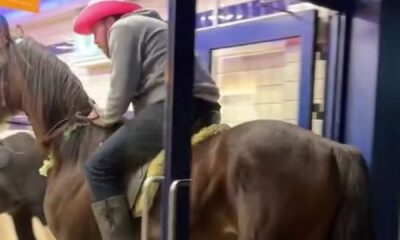
 News3 weeks ago
News3 weeks agoHungry customer left gobsmacked as two blokes riding giant HORSES stroll into local chip shop
-

 MMA3 weeks ago
MMA3 weeks agoKayla Harrison gets involved in nasty war of words with Julianna Pena and Ketlen Vieira
-

 Technology3 weeks ago
Technology3 weeks agoApple iPhone 16 Plus vs Samsung Galaxy S24+

You must be logged in to post a comment Login